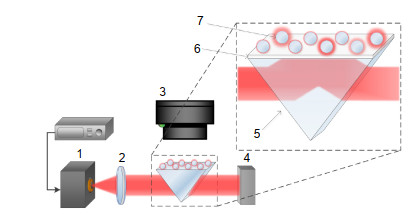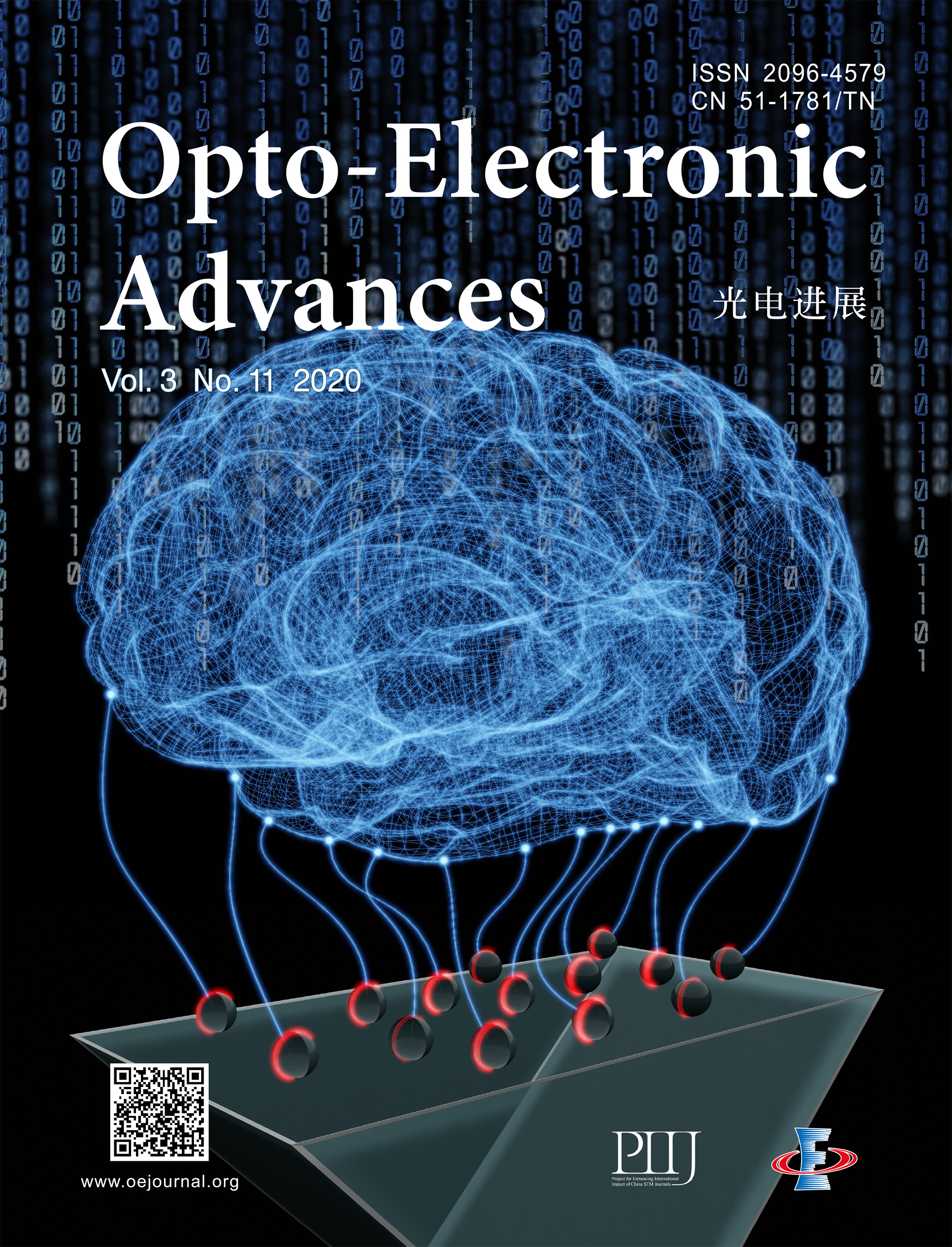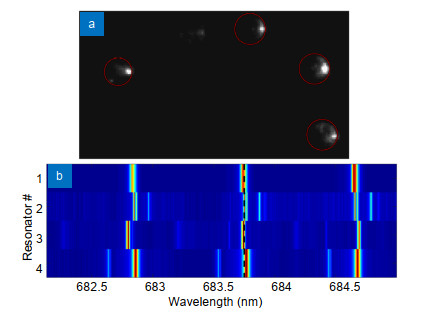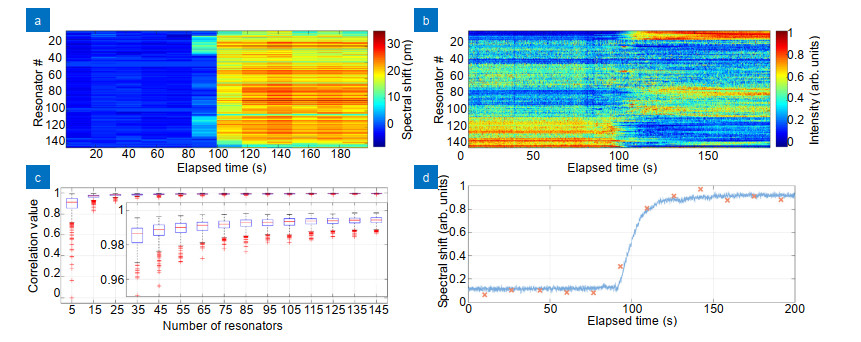| Citation: | Saetchnikov A V, Tcherniavskaia E A, Saetchnikov V A, Ostendorf A. Deep-learning powered whispering gallery mode sensor based on multiplexed imaging at fixed frequency. Opto-Electron Adv 3, 200048 (2020). doi: 10.29026/oea.2020.200048 |
Deep-learning powered whispering gallery mode sensor based on multiplexed imaging at fixed frequency
-
Abstract
During the last decades the whispering gallery mode based sensors have become a prominent solution for label-free sensing of various physical and chemical parameters. At the same time, the widespread utilization of the approach is hindered by the restricted applicability of the known configurations for ambient variations quantification outside the laboratory conditions and their low affordability, where necessity on the spectrally-resolved data collection is among the main limiting factors. In this paper we demonstrate the first realization of an affordable whispering gallery mode sensor powered by deep learning and multi-resonator imaging at a fixed frequency. It has been shown that the approach enables refractive index unit (RIU) prediction with an absolute error at 3×10-6 level for dynamic range of the RIU variations from 0 to 2×10-3 with temporal resolution of several milliseconds and instrument-driven detection limit of 3×10-5. High sensing accuracy together with instrumental affordability and production simplicity places the reported detector among the most cost-effective realizations of the whispering gallery mode approach. The proposed solution is expected to have a great impact on the shift of the whole sensing paradigm away from the model-based and to the flexible self-learning solutions.-
Keywords:
- optical microresonator /
- sensing /
- machine learning /
- whispering gallery mode /
- multiplexing
-

-
References
[1] Vollmer F, Arnold S. Whispering-gallery-mode biosensing: label-free detection down to single molecules. Nat Methods 5, 591-596 (2008). doi: 10.1038/nmeth.1221 [2] Foreman M R, Swaim J D, Vollmer F. Whispering gallery mode sensors. Adv Opt Photonics 7, 168-240 (2015). doi: 10.1364/AOP.7.000168 [3] Zhang Y N, Zhou T M, Han B, Zhang A Z, Zhao Y. Optical bio-chemical sensors based on whispering gallery mode resonators. Nanoscale 10, 13832-13856 (2018). doi: 10.1039/C8NR03709D [4] Jiang X F, Qavi A J, Huang S H, Yang L. Whispering-gallery sensors. Matter 3, 371-392 (2020). doi: 10.1016/j.matt.2020.07.008 [5] Braginsky V B, Gorodetsky M L, Ilchenko V S. Quality-factor and nonlinear properties of optical whispering-gallery modes. Phys Lett A 137, 393-397 (1989). doi: 10.1016/0375-9601(89)90912-2 [6] Vahala K J. Optical microcavities. Nature 424, 839-846 (2003). doi: 10.1038/nature01939 [7] Vollmer F, Braun D, Libchaber A, Khoshsima M, Teraoka I, et al. Protein detection by optical shift of a resonant microcavity. Appl Phys Lett 80, 4057 (2002). doi: 10.1063/1.1482797 [8] Armani D K, Kippenberg T J, Spillane S M, Vahala K J. Ultra-high-q toroid microcavity on a chip. Nature 421, 925-928 (2003). doi: 10.1038/nature01371 [9] Kippenberg T J, Spillane S M, Armani D K, Vahala K J. Fabrication and coupling to planar high-Q silica disk microcavities. Appl Phys Lett 83, 797-799 (2003). doi: 10.1063/1.1593833 [10] White I M, Oveys H, Fan X D. Liquid-core optical ring-resonator sensors. Opt Lett 31, 1319-1321 (2006). doi: 10.1364/OL.31.001319 [11] Vollmer F, Yang L. Review label-free detection with high-q microcavities: a review of biosensing mechanisms for integrated devices. Nanophotonics 1, 267-291 (2012). doi: 10.1515/nanoph-2012-0021 [12] Zhi Y Y, Yu X C, Gong Q H, Yang L, Xiao Y F. Single nanoparticle detection using optical microcavities. Adv Mate 29, 1604920 (2017). doi: 10.1002/adma.201604920 [13] Dantham V R, Holler S, Barbre C, Keng D, Kolchenko V, et al. Label-free detection of single protein using a nanoplasmonic-photonic hybrid microcavity. Nano Lett 13, 3347-3351 (2013). doi: 10.1021/nl401633y [14] Baaske M D, Vollmer F. Optical observation of single atomic ions interacting with plasmonic nanorods in aqueous solution. Nat Photonics 10, 733-739 (2016). doi: 10.1038/nphoton.2016.177 [15] He L N, Özdemir Ş K, Zhu J G, Kim W, Yang L. Detecting single viruses and nanoparticles using whispering gallery microlasers. Nat Nanotechnol 6, 428-432 (2011). doi: 10.1038/nnano.2011.99 [16] Bog U, Laue T, Grossmann T, Beck T, Wienhold T, et al. On-chip microlasers for biomolecular detection via highly localized deposition of a multifunctional phospholipid ink. Lab Chip 13, 2701-2707 (2013). doi: 10.1039/c3lc50149c [17] Chen W J, Özdemir Ş K, Zhao G M, Wiersig J, Yang L. Exceptional points enhance sensing in an optical microcavity. Nature 548, 192-196 (2017). doi: 10.1038/nature23281 [18] Zhou X, Zhang L, Pang W. Performance and noise analysis of optical microresonator-based biochemical sensors using intensity detection. Opt Express 24, 18197-18208 (2016). doi: 10.1364/OE.24.018197 [19] Reynolds T, Riesen N, Meldrum A, Fan X D, Hall J M M et al. Fluorescent and lasing whispering gallery mode microresonators for sensing applications. Laser Photonics Rev 11, 1600265 (2017). doi: 10.1002/lpor.201600265 [20] Swaim J D, Knittel J, Bowen W P. Detection of nanoparticles with a frequency locked whispering gallery mode microresonator. Appl Phys Lett 102, 183106 (2013). doi: 10.1063/1.4804243 [21] Rosenblum S, Lovsky Y, Arazi L, Vollmer F, Dayan B. Cavity ring-up spectroscopy for ultrafast sensing with optical microresonators. Nat Commun 6, 6788 (2015). doi: 10.1038/ncomms7788 [22] Righini G C, Soria S. Biosensing by wgm microspherical resonators. Sensors 16, 905 (2016). doi: 10.3390/s16060905 [23] Su J. Label-free biological and chemical sensing using whispering gallery mode optical resonators: past, present, and future. Sensors 17, 540 (2017). doi: 10.3390/s17030540 [24] Cai L, Pan J Y, Zhao Y, Wang J, Xiao S. Whispering gallery mode optical microresonators: structures and sensing applications. Phys Status Solidi A 217, 1900825 (2020). doi: 10.1002/pssa.201900825 [25] Schweiger G, Nett R, Weigel T. Microresonator array for high-resolution spectroscopy. Opt Lett 32, 2644-2646 (2007). doi: 10.1364/OL.32.002644 [26] Saetchnikov V A, Tcherniavskaia E A. Using optical resonance of whispering gallery modes in microspheres for real-time detection and identification of biological compounds. J Appl Spectrosc 77, 714-721 (2010). doi: 10.1007/s10812-010-9392-7 [27] Huckabay H A, Wildgen S M, Dunn R C. Label-free detection of ovarian cancer biomarkers using whispering gallery mode imaging. Biosens Bioelectron 45, 223-229 (2013). doi: 10.1016/j.bios.2013.01.072 [28] Petermann A B, Varkentin A, Roth B, Morgner U, Meinhardt-Wollweber M. All-polymer whispering gallery mode sensor system. Opt Express 24, 6052-6062 (2016). doi: 10.1364/OE.24.006052 [29] Saetchnikov A V, Tcherniavskaia E A, Skakun V V, Saetchnikov V A, Ostendorf A. Reusable dispersed resonators-based biochemical sensor for parallel probing. IEEE Sens J 19, 7644-7651 (2019). doi: 10.1109/JSEN.2019.2916861 [30] Saetchnikov A V, Tcherniavskaia E A, Saetchnikov V, Ostendorf A. Design and application of distributed microresonator-based systems for biochemical sensing. In Proceedings Volume 11354, Optical Sensing and Detection VI 1135427 (SPIE, 2020); https://doi.org/10.1117/12.2555391. [31] Tcherniavskaia E A, Saetchnikov V A. Application of neural networks for classification of biological compounds from the characteristics of whispering-gallery-mode optical resonance. J Appl Spectrosc 78, 457-460 (2011). doi: 10.1007/s10812-011-9486-x [32] Hu D, Zou C L, Ren H L, Lu J, Le Z C, et al. Multi-parameter sensing in a multimode self-interference micro-ring resonator by machine learning. Sensors 20, 709 (2020). doi: 10.3390/s20030709 [33] Kornienko V V, Nechepurenko I A, Tananaev P N, Chubchev E D, Baburin A S, et al. Machine learning for optical gas sensing: a leaky-mode humidity sensor as example. IEEE Sens J 20, 6954-6963 (2020). doi: 10.1109/JSEN.2020.2978931 [34] Ballard Z S, Shir D, Bhardwaj A, Bazargan S, Sathianathan S, et al. Computational sensing using low-cost and mobile plasmonic readers designed by machine learning. ACS nano 11, 2266-2274 (2017). doi: 10.1021/acsnano.7b00105 [35] Saetchnikov A, Tcherniavskaia E, Saetchnikov V, Ostendorf A. Mapping of the detecting units of the resonator-based multiplexed sensor. In Proceedings Volume 10678, Optical Micro- and Nanometrology VⅡ 106780W (SPIE, 2018); http://doi.org/10.1117/12.2309660. [36] Harris D C. Quantitative Chemical Analysis 6th ed (W. H. Freeman, New York, 2003). [37] Loock H P, Wentzell P D. Detection limits of chemical sensors: applications and misapplications. Sens Actuators B Chem 173, 157-163 (2012). doi: 10.1016/j.snb.2012.06.071 -
Access History

Article Metrics
-
Figure 1.
Overview of the instrument configuration: 1-laser diode; 2-collimation lens; 3-camera; 4-beam dump; 5-right angle optical prism; 6-adhesive thin layer; 7-microresonator.
-
Figure 2.
Overview of the WGM signal.
-
Figure 3.
Comparison of the experimental data collected in the laser frequency sweeping and the fixed frequency schemes for the same sensor sample under changing ambient refractive index.
-
Figure 4.
Sensor response on the refractive index changes.
-
Figure 5.
(a) Distribution of the absolute error values between the measured refractive indexes and the values predicted with different processing approaches: deep neural network (dNN), linear regression (LR), random forest (RF), general regression neural network (GRNN), gradient boosting (GB), and support vector regression (SVR). (b) Statistics on the performance of the refractive index prediction with dNN approach with different combinations of weights optimization methods (Adam, RMSprop, Nadam, Adagrad, and Adadelta) and activation functions (tanh, sigmoid, relu, selu, linear, and softplus).
-
Figure 6.
Statistics on the refractive index prediction accuracy represented as absolute error values for different dNN configurations with varying number of neurons (N) in the input layer (n = 16, 32, 48, 56, 64, 80, 96, 112, 128, 256, 512, 1024) and hidden layers (L) number (3, 4, 5, 6) with 2n neurons.

 E-mail Alert
E-mail Alert RSS
RSS



 DownLoad:
DownLoad:







